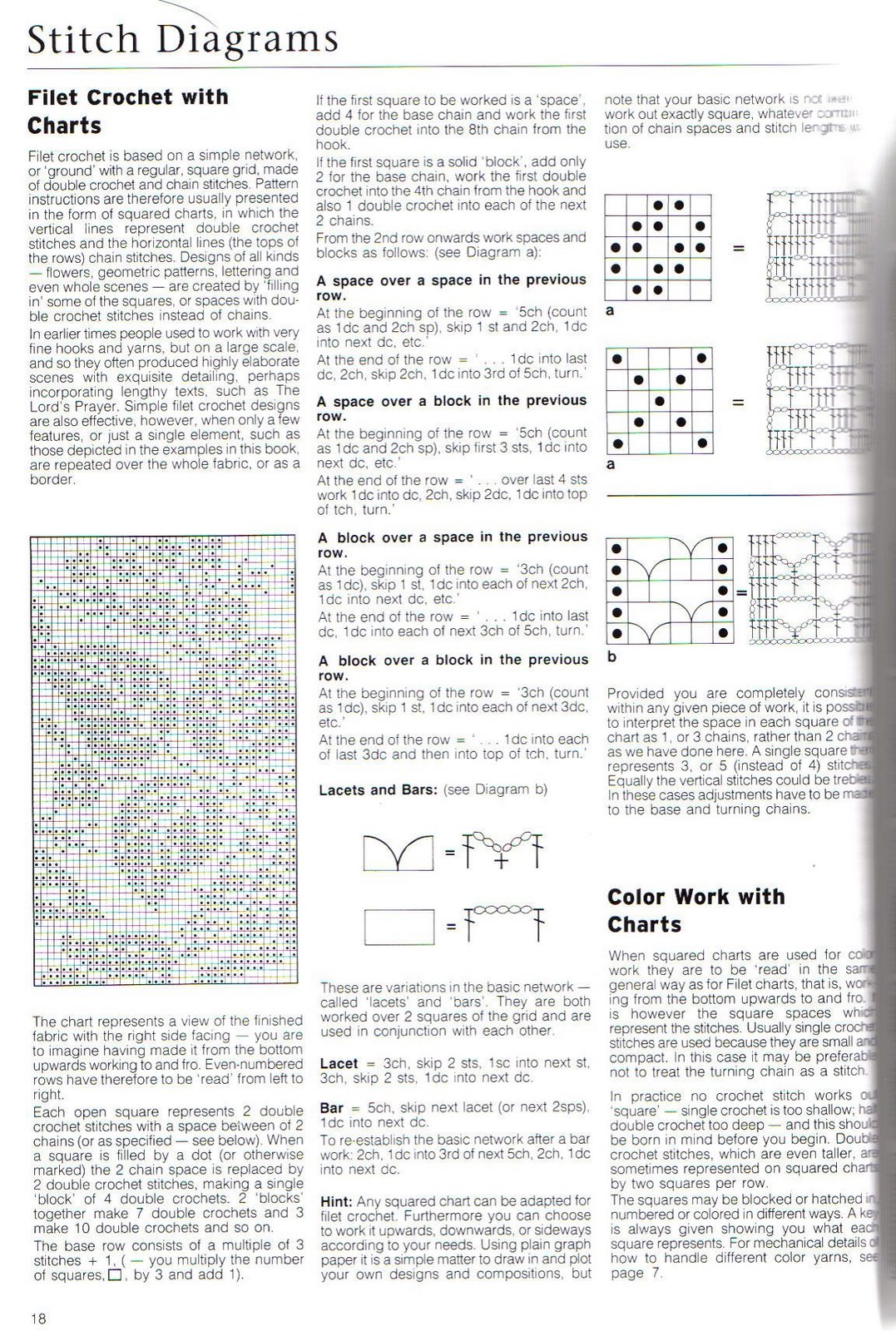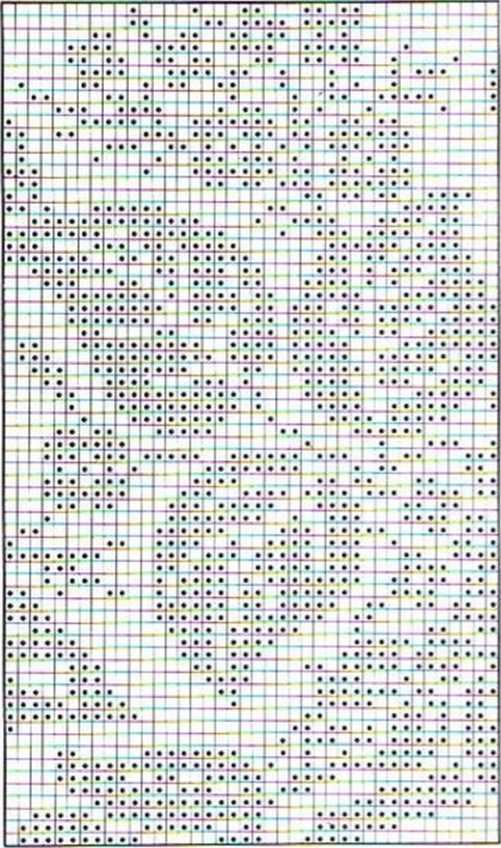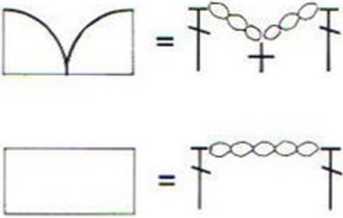46459728

Stitch Diagrams

notę that your basie network is ro* -work out exactly square, whatever :: :: tion of Chain spaces and stitch leręjr t u use.


Filet Crochet with Charts
Filet crochet is based on a simple network, or ‘ground* with a regular. square grid. madę of double crochet and Chain stitches. Pattern instructions are therefore usually presented in the form of squared charts, in which the vertical lines represent double crochet stitches and the horizontal lines (the tops of the rows) Chain stitches. Designs of all kinds — flowers, geometrie patterns, lettering and even whole scenes — are created by ‘filling in' some of the squares, or spaces with double crochet stitches instead of chains.
In earlier times people used to work with very fine hooks and yarns. but on a large scalę, and so they often produced hignly elaborate scenes with exquisite detailing, perhaps incorporating lengthy texts. such as The Lord's Prayer. Simple filet crochet designs are also effective, however, when only a few features, or just a single element, such as those depicted in the examples in this book. are repeated over the whole fabric. or as a border.
The chart represents a view of the fimshed fabric with the right side facing — you are to imagine having madę it from the bottom upwards working to and fro. Even-numbered rows have theretore to be ‘read' from left to right.
Each open square represents 2 double crochet stitches with a space between of 2 chains (or as specified — see below). When a square is filled by a dot (or otherwise marked) the 2 Chain space is replaced by 2 double crochet stitches, making a single ‘błock’ of 4 double crochets. 2 ‘blocks’ together make 7 double crochets and 3 make 10 double crochets and so on.
The base row consists of a multiple of 3 stitches + 1. ( — you multiply the number of squares.[I], by 3 and add 1).
If the first square to be worked is a ‘space'. add 4 for the base cham and work the first double crochet mto the 8th cham from the hook.
If the first square is a solid ‘błock', add only 2 for the base cham, work the first double crochet mto the 4th chain from the hook and also 1 double crochet into each of the next 2 chains.
From the 2nd row onwards work spaces and blocks as follows: (see Diagram a):
A space over a space in the previous row.
At the beginning of the row = '5ch (count as 1dc and 2ch sp), skip 1 st and 2ch, 1dc mto next dc, etc.’
At the end of the row = ‘ . . . 1dc into last dc. 2ch. skip 2ch, 1 dc into 3rd of 5ch, turn.'
A space over a błock in the previous row.
At the beginning of the row = '5ch (count as 1 dc and 2ch sp), skip first 3 sts. 1 dc into next dc, etc.'
At the end of the row = ‘... over last 4 sts work 1 dc into dc, 2ch, skip 2dc, 1 dc into top of tch, turn.’
A błock over a space in the previous row.
At the beginning of the row = ‘3ch (count as 1 dc), skip 1 st, 1 dc into each of next 2ch. 1dc into next dc. etc.’
At the end of the row = * ... 1 dc into last dc, 1dc mto each of next 3ch of 5ch, turn.'
A błock over a błock in the previous row.
At the beginning of the row = ‘3ch (count as 1 dc), skip 1 st, 1dc into each of next 3dc, etc.’
At the end of the row = * ... 1 dc mto each of last 3dc and then into top of tch. turn.’
Lacets and Bars: (see Diagram b)

These are variations in the basie network — called ‘lacets’ and ‘bars’. They are both worked over 2 squares of the grid and are used in conjunction with each other
Lacet = 3ch. skip 2 sts, fsc mto next st, 3ch, skip 2 sts. 1dc mto next dc.
Bar = 5ch, skip next lacet (or next 2sps). 1dc into next dc.
To re-estabiish the basie network after a bar work: 2ch. 1 dc mto 3rd of next 5ch, 2ch. 1 dc into next oc.
Hint: Any squared chart can be adapted for filet crochet. Furthermore you can choose to work it upwards, downwards, or sideways according to your needs. Using plam graph paper it is a simple matter to draw in and plot your own designs and compositions, but
Provided you are completely eon; within any given piece of work, it is po; to interpret the space in each square o* chart as 1, or 3 chains. rather than 2 as we have done here. A single square represents 3, or 5 (instead of 4) stit< Equally the vertical stitches could be tr< In these cases adjustments have to be to the base and turning chains.
Color Work with Charts
When squared charts are used for work they are to be ‘read’ in the generał way as for Filet charts, that is, wc ing from the bottom upwards to and fro. is however the square spaces wh> represent the stitches. Usually single stitches are used because they are smali compact. In this case it may be not to treat the turning chain as a stitch
In practice no crochet stitch works *square’ — single crochet is too shallow; double crochet too deep — and this be born in mind before you begin. crochet stitches, which are even taller, sometimes represented on squared by two squares per row.
The squares may be blocked or hatched numbered or colored in different ways. A is always given showing you what square represents. For mechanical details how to handle different color yarns, page 7.
18
Wyszukiwarka
Podobne podstrony:
Binding Off in Kitchener Rib TIP Always make surę that your yarn end is long enough for binding
CCF20100223�003 cavity than for Polish o, (2) it is morę open, i.e. the space between the back of th
and man and consequently between man and naturę is differently set up than in the age of domination
00057 ?3894d9003361260a26a45e7f0f6dd0 56 Hembree & Zirnmer where Gt = P; H’(R< + H P; H’) 1
It is inicresting to notę that because of improvcd persona! and cnvironmcntal hygicnc standnrds
particular network is stored. Among that data, the information about in what MSC/VLR service area th
What you really need is that your brain is opc Wydział Matematyki, Informatyki i Ekonometrii UZWaria
6 (388) ?=• FIGURĘ 13-16 Błock diagrams of (<?) a dojne and {b) a hasin. Notę that m a domc the o
Step Two rSTEP TWOCreate Your Job Post With The Step One Expectations Now that you have your expecta
36 Societe des Nations — * into force one month from the datę of this notę, that i
cells 4 days after tumor implantation. It is of importance to notę that in vivo depletion with anti-
essent?rving?29 C A R v I N O. Tl-IF. H l* M A N F I C, f R F. Fig 12.5 Finished małe figurę. (Notę
26950 vibro 07 KEEP EXERCISING ALL THE TIME One thing to keep in mind is that your Vibro-Power cours
00013 ?5c5a58795d3d3cd940c33cedaf2990 12 Woodall & Faltin We maintain, moreover, that before a
00451 ?79a8a0a64f5639f3dddf1b4e40ba63 456 Russell However, the extract suggests that the same proce
więcej podobnych podstron